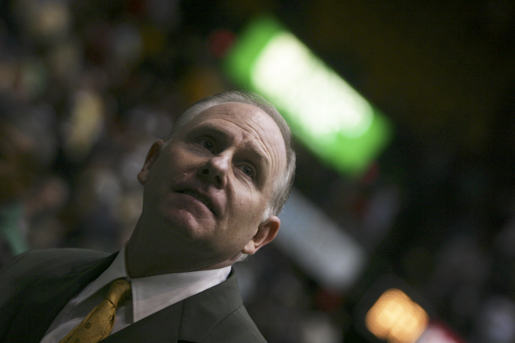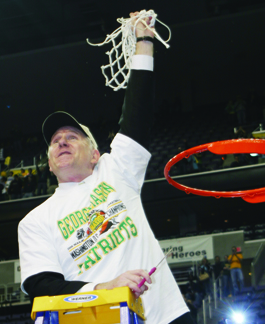Coach Larranaga on Mason's Run to the Final Four
 Men's Basketball Head Coach Jim Larranaga has been at Mason since 1997. He recently signed a new contract that will keep him at Mason until through 2015. (Broadside Photo Archives)
Men's Basketball Head Coach Jim Larranaga has been at Mason since 1997. He recently signed a new contract that will keep him at Mason until through 2015. (Broadside Photo Archives)
-------------------
UPDATED 5:36 p.m.
Jim Larranaga yells and screams toward his team, calling plays from the sidelines and occasionally challenging a referee. He has a one page philosophy that guides his life, and his team. His approach to the game gave George Mason University a story to tell, and will hopefully give it another one in the future.
“In 2005 and 2006, the George Mason team functioned so much as a single unit,”
Larranaga said. “They played so well and brought out the best in each other . . . They were able to compete with the best programs in the country.”
Before the 2006 run to the National Collegiate Athletic Association’s Final Four, Mason was a mid-major school, gaining the occasional berths in the NCAA Tournament and the National Invitational Tournament.
“Because of the run to the Final Four, we received so much recognition and exposure outside the area,” Larranaga said.
“We have been able to go to Florida and New York and convince outstanding student athletes to come to George Mason because they have become more familiar with our basketball program and our university.”
During the run, the winningest coach in Patriot history was the gracious recipient of the Clair Bee Coach of the Year Award.

Coach Jim Larranaga cuts down the game net in the celebration after Mason's surprising victory over UConn at DC's Verizon Center on March 26, 2006 launched the team into the Final Four. (Broadside Photo Archives)
Mason’s “Cinderella story” caught on nationwide, a sentiment that showed up in ESPN surveys about which team each state would be cheering for in the national championship.
“Forty-six states were cheering for George Mason,” Larranaga said. “That group of
states has become known as Mason Nation.”
Following the 2006 27-win season, the highest win total in school history, Larranaga used Mason’s increased visibility to expand his recruitment efforts across the nation
“We’re no longer a local team or a regional team,” Larranaga said. “We are a nationwide team. People not only around the United States, but actually around the world, know our name; the Final Four was what exposed those people to our university.”
In 2006, only four players hailed from outside the region of Virginia, Maryland and the District of Columbia. Two of those players were from Mali and Venezuela. For
the 2009-2010 season, eight players were from outside the area, spanning from New York, Florida and Texas.
“As the games appear more and more on television, athletes [from] all over, especially this northeast corridor from New York down to North Carolina, [are] becoming more familiar with the name ‘George Mason University,’” Larranaga said.
Larranaga has kept his coaching tactics the same, working instead to find new
ways to keep his staff and players motivated.
“I think one of the things we’ve always looked for was a certain amount of respect,” Larranaga said. “We wanted the administration, the members of the athletic department, most importantly our faculty and student body, to respect the work that we’re doing. It’s important to the coaches; it’s important to our players.”
Television coverage has also come to play in Mason basketball in a way it never did before 2006.
“When we won the eastern regional championship and were [going] to the Final Four, already what had begun was a more serious interest in television broadcasting our games,” Larranaga said. “Our athletic department, under the direction of Tom O’Connor, made a concerted effort to go out and solicit TV networks to come in and televise our games.”
Mason has kept the heightened visibility on its athletics in the four years since the
2006 run.
“Because of the number of times it’s referenced on television and radio, [the Final
Four] is never forgotten,” Larranaga said.
“It still has a major place in our history, but it’s not in the history of these students
because they were not attending George Mason at the time.”
Larranaga hopes to ride on this visibility as long as he coaches at Mason and looks
to top the incredible run. His support has come from all angles, receiving tremendous support from Mason administration, the fans and the community around him.
He is, and has been, dedicated to the school and its athletic program. He turned
down an offer to coach at the school where he was a star guard, Providence College of the Big East, and agreed to a three-year extension to stay with the Patriots.
He is now under contract through 2015. “I’ve said before that I hope to retire
here at George Mason, and this contract extension allows me to do just that,” Larranaga said in a statement.
The surroundings, his home court and his supportive fans all contribute to his love for the school and its program.
“The Patriot Center is a great facility,” Larranaga said. “As the Patriot Platoon has
grown, we’ve developed much more of a home court atmosphere, where our fans
are really excited, the fans are making noise, the band is playing and there’s a lot
more school spirit . . . Everyone feels that there is a tremendous home court advantage.”
While the increasing visibility of the school and heightened spirit for the team
have been beneficial to the program, Larranaga’s key is focusing on how each individual member of his team contributes to the overall success.
“Basketball is really the ultimate team sport,” Larranaga said. “Everybody plays
offense and defense. Everybody has a chance to score and handle the ball. Everybody has a responsibility of rebounding. It has to be a team effort.”
---------------
The above piece was published in Mason Nation: Four Years After Final Four, a magazine released this April documenting and analyzing the university's development since the Patriots' historic run in 2006, aiming to shed light on what's connected to the Cinderella story--and additionally, what's not.
Led by senior history major and Student Media veteran Rachael Dickson, the magazine's other topics include changes in men's basketball to effects on other athletics, and from player profiles of the Final Four team to the rise of the Chesapeake residential neighborhood. Gunston and the pep band also receive shout-outs.
